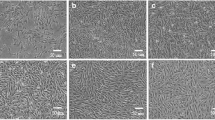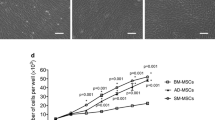Abstract
Purpose
Surgical reattachment of tendon to bone often fails due to regeneration failure of the specialised tendon–bone junction (TBJ). The use of mesenchymal stem cells for TBJ regeneration has been reported with promising results. Tendon-derived stem cells (TDSCs) with high proliferative and multi-lineage differentiation potential have been isolated. As stem cells residing in tendons, TDSCs can be considered a new cell source for TBJ repair. Bone morphogenic protein 2 (BMP-2) is a potent osteogenic factor with roles in normal bone healing and pathological ectopic bone formation in soft tissues. The use of BMP-2 to promote TBJ repair has been well reported. This study aimed to compare TDSCs to the gold standard bone-marrow-derived mesenchymal stem cells (BMSCs) with respect to osteogenic response to BMP-2 in vitro.
Method
The clonogenicity and multi-differentiation potential of TDSCs and BMSCs were identified by colony-forming-unit assay, osteogenic, adipogenic and chondrogenic differentiation assays. Their osteogenic response to BMP-2 in vitro was examined by alkaline phosphatase (ALP) cytochemical staining, ALP activity assay and Alizarin red S staining of calcium nodule formation. Messenger RNA (mRNA) and BMP receptor (types IA, IB and II) protein expression were examined by quantitative real-time reverse-transcriptase polymerase chain reaction (qRT-PCR) and Western blotting.
Results
Our results showed that both TDSCs and BMSCs exhibited stem cell properties, including clonogenicity and multi-differentiation potential. TDSCs expressed higher mRNA and protein levels of BMP receptors IA, IB and II. They also exhibited higher osteogenic differentiation with and without BMP-2 stimulation compared with BMSCs.
Conclusions
TDSCs with/without BMP-2 might be an attractive source for TBJ repair compared with BMSCs.





Similar content being viewed by others
References
Rodeo SA, Arnoczky SP, Torzilli PA, Hidaka C, Warren RF (1993) Tendon-healing in a bone tunnel. A biomechanical and histological study in the dog. J Bone Joint Surg Am 75:1795–1803
Liu SH, Panossian V, al-Shaikh R, Tomin E, Shepherd E, Finerman GA, Lane JM (1997) Morphology and matrix composition during early tendon to bone healing. Clin Orthop Relat Res 253–260.
Wong MW, Qin L, Tai JK, Lee SK, Leung KS, Chan KM (2004) Engineered allogeneic chondrocyte pellet for reconstruction of fibrocartilage zone at bone-tendon junction–a preliminary histological observation. J Biomed Mater Res B Appl Biomater 70:362–367
Ivkovic A, Marijanovic I, Hudetz D, Porter RM, Pecina M, Evans CH (2011) Regenerative medicine and tissue engineering in orthopaedic surgery. Front Biosci (Elite Ed) 3:923–944
Lim JK, Hui J, Li L, Thambyah A, Goh J, Lee EH (2004) Enhancement of tendon graft osteointegration using mesenchymal stem cells in a rabbit model of anterior cruciate ligament reconstruction. Arthrosc 20:899–910
Soon MY, Hassan A, Hui JH, Goh JC, Lee EH (2007) An analysis of soft tissue allograft anterior cruciate ligament reconstruction in a rabbit model: a short-term study of the use of mesenchymal stem cells to enhance tendon osteointegration. Am J Sports Med 35:962–971
Baksh D, Yao R, Tuan RS (2007) Comparison of proliferative and multilineage differentiation potential of human mesenchymal stem cells derived from umbilical cord and bone marrow. Stem cells 25:1384–1392
Hayashi O, Katsube Y, Hirose M, Ohgushi H, Ito H (2008) Comparison of osteogenic ability of rat mesenchymal stem cells from bone marrow, periosteum, and adipose tissue. Calcif Tissue Int 82:238–247
Bi Y, Ehirchiou D, Kilts TM, Inkson CA, Embree MC, Sonoyama W et al (2007) Identification of tendon stem/progenitor cells and the role of the extracellular matrix in their niche. Nat Med 13:1219–1227
Rui YF, Lui PP, Li G, Fu SC, Lee YW, Chan KM (2010) Isolation and characterization of multipotent rat tendon-derived stem cells. Tissue Eng Part A 16:1549–1558
Rui YF, Lui PP, Ni M, Chan LS, Lee YW, Chan KM (2011) Mechanical loading increased BMP-2 expression which promoted osteogenic differentiation of tendon-derived stem cells. J Orthop Res 29:390–396
Rodeo SA, Suzuki K, Deng XH, Wozney J, Warren RF (1999) Use of recombinant human bone morphogenetic protein-2 to enhance tendon healing in a bone tunnel. Am J Sports Med 27:476–488
Martinek V, Latterman C, Usas A, Abramowitch S, Woo SL, Fu FH, Huard J (2002) Enhancement of tendon-bone integration of anterior cruciate ligament grafts with bone morphogenetic protein-2 gene transfer: a histological and biomechanical study. J Bone Joint Surg Am 84-A:1123–1131
Hashimoto Y, Yoshida G, Toyoda H, Takaoka K (2007) Generation of tendon-to-bone interface “enthesis” with use of recombinant BMP-2 in a rabbit model. J Orthop Res 25:1415–1424
Ma CB, Kawamura S, Deng XH, Ying L, Schneidkraut J, Hays P, Rodeo SA (2007) Bone morphogenetic proteins-signaling plays a role in tendon-to-bone healing: a study of rhBMP-2 and noggin. Am J Sports Med 35:597–604
Chen CH, Liu HW, Tsai CL, Yu CM, Lin IH, Hsiue GH (2008) Photoencapsulation of bone morphogenetic protein-2 and periosteal progenitor cells improve tendon graft healing in a bone tunnel. Am J Sports Med 36:461–473
Tang Y, Tang W, Lin Y, Long J, Wang H, Liu L, Tian W (2008) Combination of bone tissue engineering and BMP-2 gene transfection promotes bone healing in osteoporotic rats. Cell Biol Int 32:1150–1157
Pecina M, Vukicevic S (2007) Biological aspects of bone, cartilage and tendon regeneration. Int Orthop 31:719–720
Osyczka AM, Damek-Poprawa M, Wojtowicz A, Akintoye SO (2009) Age and skeletal sites affect BMP-2 responsiveness of human bone marrow stromal cells. Connect Tissue Res 50:270–277
Sato R, Uchida K, Kobayashi S, Yayama T, Kokubo Y, Nakajima H et al (2007) Ossification of the posterior longitudinal ligament of the cervical spine: histopathological findings around the calcification and ossification front. J Neurosurg Spine 7:174–183
Neuwirth J, Fuhrmann RA, Veit A, Aurich M, Stonans I, Trommer T, Hortschansky P, Chubinskaya S, Mollenhauer JA (2006) Expression of bioactive bone morphogenetic proteins in the subacromial bursa of patients with chronic degeneration of the rotator cuff. Arthritis Res Ther 8:R92
Kaps C, Hoffmann A, Zilberman Y, Pelled G, Haupl T, Sittinger M et al (2004) Distinct roles of BMP receptors type IA and IB in osteo-/chondrogenic differentiation in mesenchymal progenitors (C3H10T1/2). Biofactors 20:71–84
Kawabata M, Miyazono K (2000) Bone morphogenetic proteins. In: Drnesto C (ed) Skeletal growth factors. Lippincott Williams & Wilkins, Philadelphia, pp 269–290
Tan Q, Lui PP, Rui YF (2011) Effect of in-vitro passaging on the stem cell-related properties of tendon-derived stem cells (TDSCs) - implication in tissue engineering. Stem Cells Dev. doi:10.1089/scd.2011.0160
Lui PP, Chan LS, Lee YW, Fu SC, Chan KM (2010) Sustained expression of proteoglycans and collagen type III/type I ratio in a calcified tendinopathy model. Rheumatol (Oxford) 49:231–239
Jaiswal N, Haynesworth SE, Caplan AI, Bruder SP (1997) Osteogenic differentiation of purified, culture-expanded human mesenchymal stem cells in vitro. J Cell Biochem 64:295–312
Wagner W, Horn P, Castoldi M, Diehlmann A, Bork S, Saffrich R et al (2008) Replicative senescence of mesenchymal stem cells: a continuous and organized process. PLoS One 3:e2213
Seib FP, Franke M, Jing D, Werner C, Bornhauser M (2009) Endogenous bone morphogenetic proteins in human bone marrow-derived multipotent mesenchymal stromal cells. Eur J Cell Biol 88:257–271
Tan Q, Lui PP, Rui Y, Wong YM (2011) Comparison of potentials of stem cells isolated from tendon and bone marrow for musculoskeletal tissue engineering. Tissue Eng Part A. doi:10.1089/ten.TEA.2011.0362
Blitz E, Viukov S, Sharir A, Shwartz Y, Galloway JL, Pryce BA et al (2009) Bone ridge patterning during musculoskeletal assembly is mediated through SCX regulation of Bmp4 at the tendon-skeleton junction. Dev Cell 17:861–873
Mihelic R, Pecina M, Jelic M, Zoricic S, Kusec V, Simic P et al (2004) Bone morphogenetic protein-7 (osteogenic protein-1) promotes tendon graft integration in anterior cruciate ligament reconstruction in sheep. Am J Sports Med 32:1619–1625
Yoshizawa T, Takizawa F, Iizawa F, Ishibashi O, Kawashima H, Matsuda A et al (2004) Homeobox protein MSX2 acts as a molecular defense mechanism for preventing ossification in ligament fibroblasts. Mol Cell Biol 24:3460–3472
Hoffmann A, Pelled G, Turgeman G, Eberle P, Zilberman Y, Shinar H et al (2006) Neotendon formation induced by manipulation of the Smad8 signalling pathway in mesenchymal stem cells. J Clin Invest 116:940–952
Nojima J, Kanomata K, Takada Y, Fukuda T, Kokabu S, Ohte S et al (2010) Dual roles of smad proteins in the conversion from myoblasts to osteoblastic cells by bone morphogenetic proteins. J Biol Chem 2285:15577–15586
Zhang J, Wang JH (2010) Mechanobiological response of tendon stem cells: implications of tendon homeostasis and pathogenesis of tendinopathy. J Orthop Res 28:639–643
Rui YF, Lui PP, Chan LS, Chan KM, Fu SC, Li G (2011) Does erroneous differentiation of tendon-derived stem cells contribute to the pathogenesis of calcifying tendinopathy? Chin Med J (Engl) 124:606–610
Lui PP, Chan LS, Cheuk YC, Lee YW, Chan KM (2009) Expression of bone morphogenetic protein-2 in the chondrogenic and ossifying sites of calcific tendinopathy and traumatic tendon injury rat models. J Orthop Surg Res 4:27
Lui PP, Wong YM, Rui YF, Lee YW, Chan LS, Chan KM (2011) Expression of chondro-osteogenic BMPs in ossified failed tendon healing model of tendinopathy. J Orthop Res 29:816–821
Rui YF, Lui PP, Rolf CG, Wong YM, Lee YW, Chan KM (2011) Expression of chondro-osteogenic BMPs in clinical samples of patellar tendinopathy. Knee Surg Sports Traumatol Arthrosc. doi:10.1007/s00167-011-1685-8
Arnoczky SP, Lavagnino M, Egerbacher MT (2007) The response of tendon cells to changing loads: implications in the etiopathogenesis of tendinopathy. In: Woo SLY (ed) Tendinopathy in athletes. Blackwell Publishing, USA, pp 46–59
Acknowledgements
This work was supported by equipment/resources donated by the Hong Kong Jockey Club Charities Trust and the CUHK Direct Grant (Ref no. 2010.1.063).
Author information
Authors and Affiliations
Corresponding author
Rights and permissions
About this article
Cite this article
Rui, Y.F., Lui, P.P.Y., Lee, Y.W. et al. Higher BMP receptor expression and BMP-2-induced osteogenic differentiation in tendon-derived stem cells compared with bone-marrow-derived mesenchymal stem cells. International Orthopaedics (SICOT) 36, 1099–1107 (2012). https://doi.org/10.1007/s00264-011-1417-1
Received:
Accepted:
Published:
Issue Date:
DOI: https://doi.org/10.1007/s00264-011-1417-1




